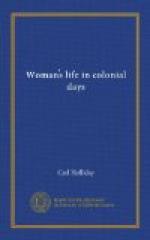Those were harsh times, and many a man or woman showed heroic qualities under the strain. The editor of Sewall’s Diary makes this comment upon the silent heroism of the martyr, Giles Cory: “At first, apparently, a firm believer in the witchcraft delusion, even to the extent of mistrusting his saintly wife, who was executed three days after his torturous death, his was the most tragic of all the fearful offerings. He had made a will, while confined in Ipswich jail, conveying his property, according to his own preferences, among his heirs; and, in the belief that his will would be invalidated and his estate confiscated, if he were condemned by a jury after pleading to the indictment, he resolutely preserved silence, knowing that an acqittance was an impossibility."[27b]
In the case of Cory doubtless the majority of the people thought the manner of death, like that of Anne Hutchinson, was a fitting judgment of God; for Sewall records in his ever-helpful Diary: “Sept. 20. Now I hear from Salem that about 18 years agoe, he [Giles Cory] was suspected to have stamp’d and press’d a man to death, but was cleared. Twas not remembered till Ann Putnam was told of it by said Cory’s Spectre the Sabbath day night before the Execution."[28]
The Corys, Eastys, and Putnams were families exceedingly prominent during the entire course of the mania; Ann Putnam’s name appears again and again. She evidently was a woman of unusual force and impressive personality, and many were her revelations concerning suspected persons and even totally innocent neighbors. Such workers brought distressing results, and how often the helpless victims were women! Hear these echoes from the gloomy court rooms: “September 17: Nine more received Sentence of Death, viz., Margaret Scot of Rowly, Goodwife Reed of Marblehead, Samuel Wardwell, and Mary Parker of Andover, also Abigail Falkner of Andover ... Rebecka Eames of Boxford, Mary Lacy and Ann Foster of Andover, and Abigail Hobbs of Topsfield. Of these Eight were Executed."[29] And Cotton Mather in a letter to a friend: “Our Good God is working of Miracles. Five Witches were lately Executed, impudently demanding of God a Miraculous Vindication of their Innocency."[30]
And yet how absurd was much of the testimony that led to such wholesale murder. We have seen some of it already. Note these words by a witness against Martha Carrier, as presented in Cotton Mather’s Wonders of the Invisible World: “The devil carry’d them on a pole to a witch-meeting; but the pole broke, and she hanging about Carrier’s neck, they both fell down, and she then received an hurt by the fall whereof she was not at this very time recovered.... This rampant hag, Martha Carrier, was the person, of whom the confessions of the witches, and of her own children among the rest, agreed, that the devil had promised her she should be Queen of Hell.”




